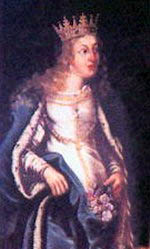- Elizabeth of Aragon
Infobox Saint
name=Saint Elizabeth of Portugal
birth_date=1271
death_date=4 July 1336
feast_day=4 July ;8 July (1694-1969 calendars)
venerated_in=
imagesize=150px
caption="Saint Elizabeth of Portugal" Statue in the Church of the Mafra Palace, Portugal
birth_place=Aljafería Palace,Zaragoza ,Kingdom of Aragon ["Lives of the Saints, For Every Day of the Year," edited by Rev. Hugo Hoever, S.O.Cist.,Ph.D., New York: Catholic Book Publishing Co., 1955, p.257]
death_place=Estremoz Castle inEstremoz ,Alentejo ,Kingdom of Portugal
titles=Queen and Widow
beatified_date=
beatified_place=
beatified_by=
canonized_date=25 May 1625
canonized_place=Rome
canonized_by=Pope Urban VIII
attributes=
patronage=Third Order of St Francis
major_shrine=Monastery of Santa Clara-a-Nova ,Coimbra ,Portugal ["LIves of the Saints, For Every Day of the Year," p. 257]
suppressed_date=
issues=
prayer=
prayer_attrib=Saint Elizabeth of Portugal [The name given to her in the
Roman Missal ] also known as Elizabeth of Aragon (1271–4 July 1336 ) ("Elisabet" in Catalan, "Isabel" in both Portuguese and Spanish) was queen consort ofPortugal and is asaint of theRoman Catholic Church .Biography
Marriage
Saint Elizabeth showed an early enthusiasm for religion: she said the full Divine Office daily, fasted and did other penances, and attended twice daily choral masses.
Elizabeth was married very early to King
Denis of Portugal , a poet, and known as "Rei Lavrador", or the farmer king, because he planted a large pine forest, nearLeiria . The wood from these trees would later be used to make the ships during the discoveries. Elizabeth quietly pursued the regular religious practices of her maidenhood, and was devoted to the poor and sick. Naturally, such a life was a reproach to many around her, and caused ill will in some quarters. A popular story is told of how her husband's jealousy was roused by an evil-speaking page; of how he condemned the queen's supposed guilty accomplice to a cruel death; and was finally convinced of her innocence by the strange accidental substitution of her accuser for the intended victim.They had two children, a daughter named Constance, who married King
Ferdinand IV of Castile , and a son Afonso who later became KingAfonso IV of Portugal . The latter so greatly resented the favors shown to the king's illegitimate sons that he rebelled, and in the year 1323 war was declared between him and his father. Elizabeth, however, reconciled her husband and son, and is known in consequence as the "peacemaker."Dowager Queen
King Denis died in the year 1325, and his son Afonso succeeded him. Elizabeth then retired to the convent of the Poor Clares (now known as the
Monastery of Santa Clara-a-Velha ) which she had founded in the year 1314 atCoimbra . She took the habit of theFranciscan Order , wishing to devote the rest of her life to the poor and sick in obscurity. But she was called forth to act once more as peacemaker. In 1336 Afonso IV marched his troops against theAlfonso XI of Castile , to whom he had married his daughter Maria, and who had neglected and ill-treated her. In spite of age and weakness, the queen dowager insisted on hurrying toEstremoz , where the two kings' armies were drawn up. She again stopped the fighting and caused terms of peace to be arranged. But the exertion brought on her final illness; and as soon as her mission was fulfilled she died of a fever onJuly 4 ,1336 at Estremoz Castle.St Elizabeth was buried at the
Monastery of Santa Clara-a-Velha inCoimbra , in a magnificent Gothic sarcophagus. In the early 17th century, her remains were transferred to a new sarcophagus made of silver and glass. After the monastery was abandoned due to frequent floods, her tomb was transferred to the new Monastery of Santa Clara-a-Nova, Coimbra, were it can be visited today.Canonization and Feast Day
Miracles were said to have followed upon her death. She was
canonized byPope Urban VIII on25 May 1625 , [cite encyclopedia| last = Ott| first = Michael T.| title = Pope Urban VIII| encyclopedia = The Catholic Encyclopedia| volume = XV| publisher = Robert Appleton Company| location = New York| year = 1912| url = http://www.newadvent.org/cathen/15218b.htm| accessdate = 2007-09-07 ] and her feast was inserted in the Roman Catholic Calendar of Saints for celebration on4 July . In the year 1694Pope Innocent XII moved her feast to8 July , so it would not conflict with the celebration of the Octave of Saints Peter and Paul, Apostles. ["Calendarium Romanum" (Libreria Editrice Vaticana, 1969), p. 96] In 1955Pope Pius XII abolished this octave. [General Roman Calendar of Pope Pius XII ] The 1962 Roman Missal changed the rank of the feast from "Double" to "Third-Class Feast". [3rd Class] The 1969 reform of the Calendar classified the celebration as an optional "Memorial" and restored it to the date of4 July .Family and Ancestors
She was named after her great-aunt Saint Elizabeth of Hungary, but was known in Portuguese and Spanish as "Isabel." She was the younger sister of King
Alfonso III of Aragon and KingJames II of Aragon . She was also the older sister of KingFrederick III of Sicily .ahnentafel4
style = font-size: 90%
Elizabeth of Aragon
Peter III of Aragon
Constantia of Hohenstaufen
James I of Aragon
Violant of Hungary
Manfred of Sicily
Beatrice of Savoy
Peter II of Aragon
Marie of Montpellier
Andrew II of Hungary
Yolande de Courtenay
Frederick II, Holy Roman Emperor
Bianca, Countess of Lancia
Amadeus IV of Savoy
Anne of Burgundy References
*"Lives of the Saints, For Every Day of the Year," edited by Rev. Hugo Hoever, S.O.Cist., Ph.D., New York: Catholic Book Publishing Co., 1955, pp 511
*catholicExternal links
* [http://www.newadvent.org/cathen/05391a.htm Catholic Encyclopedia: "St. Elizabeth of Portugal"]
Wikimedia Foundation. 2010.
